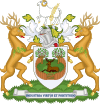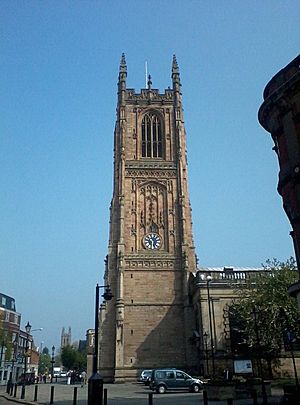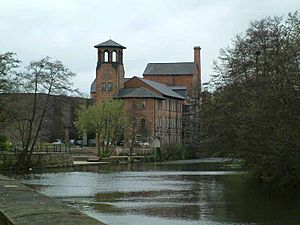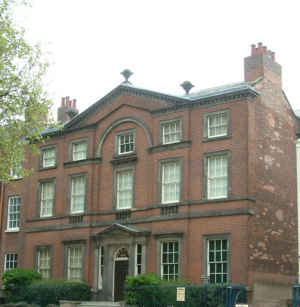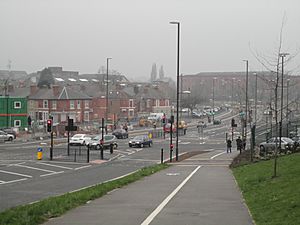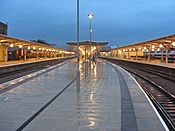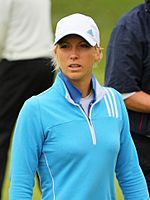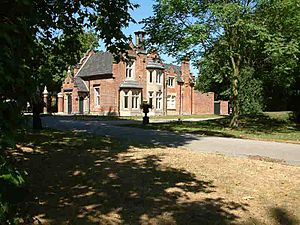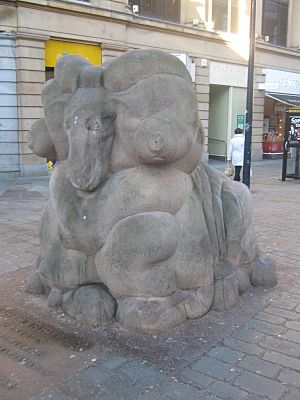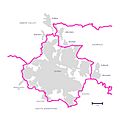Derby facts for kids
Quick facts for kids
Derby
|
||
|---|---|---|
|
City and unitary authority area
|
||
| City of Derby | ||

Derby Skyline and landmarks, clockwise from top left: Quad, Derby Cathedral, Derbion
|
||
|
||
| Motto(s):
"Industria, Virtus, et Fortitudo"
|
||

Shown within Derbyshire
|
||
| Sovereign state | United Kingdom | |
| Country | England | |
| Region | East Midlands | |
| Ceremonial county | Derbyshire | |
| Admin HQ | Derby | |
| Settled | AD 600 | |
| City status | 1977 | |
| Government | ||
| • Type | Unitary authority, city | |
| Area | ||
| • City and unitary authority area | 30.13 sq mi (78.03 km2) | |
| Population
(2011 Census)
|
||
| • City and unitary authority area | 248,700 | |
| • Density | 7,840/sq mi (3,028/km2) | |
| • Urban | 270,500 | |
| • Metro | 1,543,000 (Nottingham-Derby) | |
| • Ethnicity (Office for National Statistics 2011 Census) |
|
|
| Time zone | UTC+0 (Greenwich Mean Time) | |
| Postcode span |
DE1, DE3, DE21-24, DE73
|
|
| Area code(s) | 01332 | |
| Grid Ref. | SK3536 | |
| ONS code |
|
|
| ISO 3166-2 | GB-DER | |
| NUTS 3 | UKF11 | |
| Demonym | Derbeian | |
Derby ( DAR-bee) is a city and unitary authority area in Derbyshire, England. It lies on the banks of the River Derwent in the south of Derbyshire, of which it was traditionally the county town. Derby gained city status in 1977, and by the 2011 census its population was 248,700.
Derby was settled by Romans, who established the town of Derventio, later captured by the Anglo-Saxons, and later still by the Vikings, who made their town of Djúra-bý one of the Five Boroughs of the Danelaw. Initially a market town, Derby grew rapidly in the industrial era. Home to Lombe's Mill, an early British factory, Derby has a claim to be one of the birthplaces of the Industrial Revolution. It contains the southern part of the Derwent Valley Mills World Heritage Site. With the arrival of the railways in the 19th century, Derby became a centre of the British rail industry.
Derby is a centre for advanced transport manufacturing, being home to the world's second largest aero-engine manufacturer: Rolls-Royce. Bombardier Transportation has a production facility at the Derby Litchurch Lane Works while Toyota Manufacturing UK's automobile headquarters is located southwest of the city at Burnaston.
Contents
History
Origins
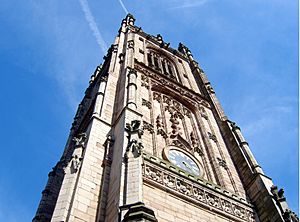
The Roman camp of 'Derventio' was probably at Little Chester/Chester Green , the site of the old Roman fort. Later the town was one of the 'Five Boroughs' (fortified towns) of the Danelaw, until it was captured by Lady Aethelflaed of Mercia in July 917, subsequent to which the town was annexed into the Kingdom of Mercia.
The Viking name Djúra-bý, recorded in Old English as Deoraby, means "Village of the Deer". This popular belief is asserted by Tim Lambert who states, "The name Derby is derived from the Danish words deor by meaning deer settlement."
However the origin of the name "Derby" would seem to be elusive: some assert that it is a corruption of the original Roman name 'Derventio' and others that the name could be linked with the river which flows through it, the Derwent, in that Derby could be a shortened version of Derwent by, meaning "Derwent settlement". The name "Derwent" is Celtic and means "a valley thick with oaks".
The town name appears, nevertheless, as 'Darby' or 'Darbye' on early modern maps, such as that of Speed (1610).
Modern research (2004) into the history and archaeology of Derby has provided evidence that the Vikings and Anglo-Saxons probably co-existed, occupying two areas of land surrounded by water. The Anglo-Saxon Chronicle (c. 900) says that "Derby is divided by water". These areas of land were known as Norþworþig ("Northworthy", = "north enclosure") and Deoraby, and were at the "Irongate" (north) side of Derby.
16th – 18th centuries
During the Civil War of 1642–1646, Derby was garrisoned by Parliamentary troops commanded by Sir John Gell, 1st Baronet, who was appointed Governor of Derby in 1643. These troops took part in the defence of nearby Nottingham, the Siege of Lichfield, the Battle of Hopton Heath and many other engagements in Nottinghamshire, Staffordshire and Cheshire, as well as successfully defending Derbyshire against Royalist armies.
A hundred years later, Bonnie Prince Charlie set up camp at Derby on 4 December 1745, whilst on his way south to seize the British crown. The prince called at The George Inn on Irongate, where the Duke of Devonshire had set up his headquarters, and demanded billets for his 9,000 troops.
He stayed at Exeter House, Full Street where he held his "council of war". A replica of the room is on display at Derby Museum in the city centre. He had received misleading information about an army coming to meet him south of Derby. Although he wished to continue with his quest, he was over-ruled by his fellow officers. He abandoned his invasion at Swarkestone Bridge on the River Trent just a few miles south of Derby. As a testament to his belief in his cause, the prince – who on the march from Scotland had walked at the front of the column – made the return journey on horseback at the rear of the bedraggled and tired army.
Industrial Revolution
Derby and Derbyshire were among the centres of Britain's Industrial Revolution. In 1717, Derby was the site of the first water-powered silk mill in Britain, built by John Lombe and George Sorocold, after Lombe had reputedly stolen the secrets of silk-throwing from Piedmont in Italy (he is alleged to have been poisoned by the Piedmontese as revenge in 1722).
In 1759, Jedediah Strutt patented and built a machine called the Derby Rib Attachment that revolutionised the manufacture of hose. This attachment was used on the Rev. Lee's Framework Knitting Machine; it was placed in front of – and worked in unison with – Lee's Frame, to produce ribbed hose (stockings). The partners were Jedediah Strutt, William Woollatt (who had been joined in 1758 by John Bloodworth and Thomas Stafford, all leading hosiers in Derby). The patent was obtained in January 1759. After three years, Bloodworth and Stafford were paid off, and Samuel Need – a hosier of Nottingham – joined the partnership. The firm was known as Need, Strutt and Woollatt. The patent expired in 1773, though the partnership continued until 1781 when Need died.
| Historical population | ||
|---|---|---|
| Year | Pop. | ±% |
| 1801 | 14,695 | — |
| 1851 | 48,506 | +230.1% |
| 1901 | 118,469 | +144.2% |
| 1921 | 142,824 | +20.6% |
| 1941 | 167,321 | +17.2% |
| 1951 | 181,423 | +8.4% |
| 1961 | 199,578 | +10.0% |
| 1971 | 219,558 | +10.0% |
| 1981 | 214,424 | −2.3% |
| 1991 | 225,296 | +5.1% |
| 2001 | 221,716 | −1.6% |
| 2011 | 248,700 | +12.2% |
Messrs Wright, the bankers of Nottingham, recommended that Richard Arkwright apply to Strutt and Need for finance for his cotton spinning mill. The first mill opened in Nottingham in 1770 and was driven by horses. In 1771 Richard Arkwright, Samuel Need and Jedediah Strutt built the world's first commercially successful water-powered cotton spinning mill at Cromford, Derbyshire, developing a form of power that was to be a catalyst for the Industrial Revolution.
This was followed in Derbyshire by Jedediah Strutt's cotton spinning mills at Belper. They were: South Mill, the first, 1775; North Mill, 1784, which was destroyed by fire on 12 January 1803 and then rebuilt; it started work again at the end of 1804; West Mill, 1792, commenced working 1796; Reeling Mill, 1897; Round Mill, which took 10 years to build, from 1803 to 1813, and commenced working in 1816; and Milford Mills, 1778. The Belper and Milford mills were not built in partnership with Arkwright. These mills were all Strutt owned and financed.
Other notable 18th-century figures with connections to Derby include the painter Joseph Wright, known as Wright of Derby, who was known for his innovative use of light in his paintings and was an associate of the Royal Academy; and John Whitehurst, a clockmaker and philosopher. Erasmus Darwin, doctor, scientist, philosopher and grandfather of Charles Darwin, whose practice was based in Lichfield, Staffordshire was a frequent visitor to Derby, having founded the Derby Philosophical Society.
The beginning of the next century saw Derby emerging as an engineering centre with manufacturers such as James Fox, who exported machine tools to Russia.
In 1840, the North Midland Railway set up its works in Derby and, when it merged with the Midland Counties Railway and the Birmingham and Derby Junction Railway, to form the Midland Railway, Derby became its headquarters.
The connection with the railway encouraged others, notably Andrew Handyside, Charles Fox and his son Francis Fox.
A permanent military presence was established in the city with the completion of Normanton Barracks in 1877.
Derby was one of the boroughs reformed by the Municipal Corporations Act 1835, and it became a county borough with the Local Government Act 1888. The borough expanded in 1877 to include Little Chester and Litchurch, and then in 1890 to include New Normanton and Rowditch. The borough did not increase substantially again until 1968, when under a recommendation of the Local Government Boundary Commission it was expanded into large parts of the rural district of Belper, Repton and South East Derbyshire. This vastly increased Derby's population from 132,408 in the 1961 census to 219,578 in the 1971 census.
Despite being one of the areas of Britain furthest from the sea, Derby holds a special place in the history of marine safety – it was as MP for Derby that Samuel Plimsoll introduced his bills for a 'Plimsoll line' (and other marine safety measures). This failed on first introduction, but was successful in 1876 and contributed to Plimsoll's re-election as an MP.
20th century to present day
An industrial boom began in Derby when Rolls-Royce opened a car and aircraft factory in the town in 1907. In 1923, the Midland Railway became part of the London, Midland and Scottish Railway with headquarters in London. However, Derby remained a major rail manufacturing centre, second only to Crewe and Wolverton. Moreover, it remained a design and development centre and in the 'thirties, on the direction of Lord Stamp, the LMS Scientific Research Laboratory was opened on London Road.
In 1911 the Derby Wireless Club was formed by a group of local engineers and experimenters. It was to be the first radio or 'wireless club' in the country.
In World War I, Derby was targeted by German Zeppelin air bombers, who killed five people in a 1916 raid on the town.
All Saints Church was designated as a cathedral in 1927, signalling that the town was ready for city status.
Slum clearance in the 1920s and 1930s saw the central area of Derby become less heavily populated as families were rehoused on new council estates in the suburbs, where houses for private sale were also constructed. Rehousing, council house building and private housing developments continued on a large scale for some 30 years after the end of World War II in 1945.
Production and repair work continued at the railway works. In December 1947 the Locomotive Works unveiled Britain's first mainline passenger diesel-electric locomotive – "Number 10000". In 1958 production switched over to diesel locomotives completely. Meanwhile, the Carriage and Wagon Works were building the first of the Diesel Multiple Units which were to take over many of the services.
In 1964 the British Rail Research Division opened to study all aspects of railway engineering from first principles. Its first success was in drastically improving the reliability and speed of goods trains, work which led to the development of the Advanced Passenger Train.
Derby was awarded city status on 7 June 1977 by Queen Elizabeth II to mark the 25th anniversary of her ascension to the throne. The Queen presented the "charter scroll" or 'letters patent' in person on 28 July 1977 on the steps of the Council House to the then Mayor Councillor Jeffrey Tillet (Conservative). Until then, Derby had been one of the few towns in England with a cathedral but not city status.
Derby holds an important position in the history of the Labour movement, because it was one of two seats (the other being Keir Hardie's in Merthyr Tydfil) gained by the recently formed Labour Representation Committee at the 1900 general election. The MP was Richard Bell, General Secretary of the Railway Servants Union. Bell was succeeded in 1910 by Jimmy Thomas and he in turn by the distinguished polymath and Nobel Laureate Philip Noel-Baker in 1936.
Despite its strategic industries (rail and aero-engine), Derby suffered comparatively little damage in both world wars (contrast Bristol and Filton). This may in part have been due to the jamming against the German radio-beam navigations systems (X-Verfahren and Knickebein, camouflage and decoy techniques ('Starfish sites') were built, mainly south of the town, e.g. out in fields near Foremark (ref. Kirk, Felix & Bartnik, 2002, see talk; see also).
Derby has also become a significant cultural centre for the deaf community in Britain. Many deaf people move to Derby because of its strong sign language-using community. It is estimated that the deaf population in Derby is at least three times higher than the national average, and that only London has a larger deaf population. The Royal School for the Deaf on Ashbourne Road provides education in British Sign Language and English.
Geography
Derby is situated in a relatively low-lying area along the lower valley of the River Derwent and lies between the lowlands and valley of the River Trent to the south, and the south east foothills of the Pennines to the north which extend to the Peak District National Park further on. The city is bordered by four national character areas which include the Trent Valley Washlands to the south, the Nottinghamshire, Derbyshire and Yorkshire Coalfields in the east, the South Derbyshire Claylands in the west, and the Derbyshire Peak Fringe in the north. Most of the flat plains surrounding Derby lie in the Trent Valley Washlands and South Derbyshire Claylands while the hillier northern parts of the city lie within the Derbyshire Peak Fringe and the Coalfields.
Nearby settlements
 |
Buxton, Bakewell, Glossop, Manchester | Duffield, Belper, Matlock | Ilkeston, Heanor, Eastwood, Alfreton, Swanwick Clay Cross, Ripley, Mansfield, Chesterfield, Sheffield |  |
| Ashbourne, Uttoxeter, Stoke on Trent | Nottingham, Borrowash, Breaston, Long Eaton, Beeston, Ockbrook | |||
| Burton on Trent, Lichfield, Birmingham | Swadlincote, Castle Donington, Melbourne, Ashby-de-la-Zouch, Coventry | Kegworth, Loughborough, Leicester |
Industry
Derby's two biggest employers, Rolls-Royce plc and the Toyota Motor Corporation are engaged in engineering manufacturing. Other companies of note include railway systems engineering firm Bombardier Transportation who manufacture railway rolling stock at the Derby Carriage and Wagon Works, HeroTSC, who deal with much of Sky's telephone support, and Alstom who manufacture large power plant boilers and heat exchangers.
Derby was for many years a railway centre, being the former headquarters of the Midland Railway, with both British Rail workshops and research facilities in the town. Although much less important than in years gone by, limited train manufacture still continues in Derby and Derby railway station retains an important position in the railway network. The city is favoured as a site for a national railway centre.
From 1922 Sinfin Lane was the home of the 62-acre (250,000 m2) site of International Combustion, originally manufacturers of machinery for the automatic delivery of pulverised fuel to furnaces and boilers, and later producing steam-generating boilers for use in electrical generating plant such as used in power stations. In the 1990s the firm was bought by Rolls-Royce plc and then sold on again to ABB Group.
Derby was the home of Core Design (originally based on Ashbourne Road), who developed the successful video game Tomb Raider. When Derby's inner ring road was completed in 2010, a section of it was named 'Lara Croft Way' after the game's heroine Lara Croft.
One of Derby's longest-established businesses is Royal Crown Derby, which has been producing porcelain since the 1750s.
The Midlands Co-operative Society, a predecessor of Central England Co-operative, traced its origins to Derby Co-operative Provident Society which, in 1854, was one of the first co-operatives in the region.
Infinity Park Derby is a planned business park for aerospace, rail and automotive technology adjacent to the Rolls-Royce site in Sinfin. In December 2014, the government announced that the park would gain enterprise zone status by being added to Nottingham Enterprise Zone.
Climate
Under the Köppen climatic classification, Derby, in spite of its distance to large bodies of water, has an oceanic climate along with the rest of the British Isles. The readings are from the closest station available in Watnall, but climate tends to be very similar between stations and cities in the region, although the Watnall station is located at a somewhat higher elevation, 17 kilometres (11 mi) to the north.
| Climate data for Watnall | |||||||||||||
|---|---|---|---|---|---|---|---|---|---|---|---|---|---|
| Month | Jan | Feb | Mar | Apr | May | Jun | Jul | Aug | Sep | Oct | Nov | Dec | Year |
| Average high °C (°F) | 6.6 (43.9) |
7.0 (44.6) |
9.7 (49.5) |
12.5 (54.5) |
16.1 (61.0) |
18.9 (66.0) |
21.3 (70.3) |
21.0 (69.8) |
17.9 (64.2) |
13.7 (56.7) |
9.7 (49.5) |
6.7 (44.1) |
13.4 (56.2) |
| Average low °C (°F) | 1.3 (34.3) |
1.1 (34.0) |
2.8 (37.0) |
4.3 (39.7) |
7.1 (44.8) |
10.0 (50.0) |
12.1 (53.8) |
12.0 (53.6) |
10.0 (50.0) |
7.1 (44.8) |
3.9 (39.0) |
1.6 (34.9) |
6.1 (43.0) |
| Average precipitation mm (inches) | 61.2 (2.41) |
47.2 (1.86) |
49.5 (1.95) |
53.8 (2.12) |
51.8 (2.04) |
62.5 (2.46) |
57.6 (2.27) |
62.0 (2.44) |
58.6 (2.31) |
71.2 (2.80) |
65.7 (2.59) |
68.6 (2.70) |
709.4 (27.93) |
| Average precipitation days | 11 | 10 | 11 | 10 | 9 | 9 | 9 | 9 | 9 | 11 | 11 | 12 | 121 |
| Mean monthly sunshine hours | 54.7 | 73.2 | 104.2 | 141.0 | 181.6 | 170.6 | 191.1 | 180.1 | 131.2 | 99.4 | 63.7 | 49.2 | 1,440.1 |
| Source: Met Office | |||||||||||||
Landmarks
Derby Cathedral tower is 212 feet (68.6 meters) tall to the tip of the pinnacles. This has been home to a pair of breeding peregrine falcons since 2006. Four webcams monitor the falcons here.
Derby Gaol is a visitor attraction based in the dungeons of the Derbyshire County Gaol which dates back to 1756.
Derby Industrial Museum is situated in Derby Silk Mill and shows the industrial heritage and technological achievement of Derby, including Rolls-Royce aero engines, railways, mining, quarrying and foundries. The Silk Mill stands at the southern end of the 24 km (15 mi) stretch of the River Derwent designated a World Heritage Site in 2001.
Pickford's House Museum was built by architect Joseph Pickford in 1770. It was his home and business headquarters. Derby Museum and Art Gallery shows paintings by Joseph Wright, as well as fine Royal Crown Derby porcelain, natural history, local regiments and archaeology. Pickford also designed St Helen's House in King Street.
The skyline of the inner city changed in 1968 when the inner ring road with its two new crossings of the River Derwent was built. The route of the ring road went through the St. Alkmund's Church and its Georgian churchyard, the only Georgian square in Derby. Both were demolished to make way for the road, a move still criticised today. Thus the editor (Elizabeth Williamson) of the 2nd edition of Pevsner for Derbyshire wrote: '...the character and cohesion of the centre has been completely altered by the replacement of a large number of C18 houses in the centre by a multi-lane road. As a traffic scheme this road is said to be a triumph; as townscape it is a disaster.'
Places of interest
- Cathedral Quarter
- Darley Abbey
- Derby Arboretum
- Derby Canal
- Derby Cathedral
- Derby Museum and Art Gallery
- Derby Industrial Museum (Silk Mill)
- St Mary's Church, Derby
- Derby Friargate Station (of which all that remains is Handyside's bridge and the bridge across Friargate)
- iPro Stadium (Derby County F.C.) and its predecessor the Baseball Ground (now demolished)
- River Derwent
- St Helen's House, Derby
- Derby Catacombs
- Intu shopping centre
- Saint Benedict Catholic School and Performing Arts College secondary school
- Royal Crown Derby Museum and Factory Tour
- Pickford's House Museum
Transport
Roads
The city has extensive transport links with other areas of the country. The M1 motorway passes about ten miles (16 km) east of the city, linking Derby southwards to the London area and northwards to Sheffield and Leeds. Other major roads passing through or near Derby include the A6 (historically the main route from London to Carlisle, also linking to Leicester and Manchester), A38 (Bodmin to Mansfield via Bristol and Birmingham), A50 (Warrington to Leicester via Stoke-on-Trent), A52 (Newcastle-under-Lyme to Mablethorpe, including Brian Clough Way linking Derby to Nottingham) and A61 (Derby to Thirsk via Sheffield and Leeds).
On 16 March 2011, Mercian Way, the final section of the city's inner ring road, was opened to traffic. This new section connects Burton Road with Uttoxeter New Road, and crosses Abbey Street. Abbey Street is the only road between the two ends from which Mercian Way can be accessed.
Railways
Derby railway station is operated by East Midlands Railway and is served by express services to London, the North East and South West, provided by East Midlands and CrossCountry. There also remain local stations at Peartree and Spondon, although services are limited, especially at the former.
Air
East Midlands Airport is about fifteen miles (24 km) from Derby city centre. Its proximity to Derby, the fact that the airport is in Leicestershire, and the traditional rivalry between the three cities (Derby, Leicester and Nottingham), meant that there was controversy concerning the airport's decision to prefix its name with Nottingham in 2004. In 2006, Nottingham East Midlands Airport reverted to its previous name. The airport is served by budget airlines, including Ryanair and Jet2, with services to domestic and European destinations.
Derby Airfield, approximately 7 miles (11 km) southwest of the city centre, has grass runways targeted at general aviation.
Bus and coach
The Derby bus station has 29 bays, 5 for coaches and 24 for general bus services. Local bus services in and around Derby are run by a number of companies, but principally Trentbarton and Arriva Midlands. The city is on National Express' London to Manchester and Yorkshire to the South West routes.
Culture, entertainment and sport
On 8 October 2021 it was announced that Derby had been included in the longlist of bids to host UK City of Culture 2025, but in March 2022 it failed to make it onto the shortlist.
Music
In rock music, the blues singer-songwriter Kevin Coyne came from Derby, as does the three-piece rock band LostAlone, and indie/glam rock band The Struts. The ska punk band Lightyear also hail from the city, naming their second album Chris Gentlemens Hairdresser and Railway Book Shop after a shop in Macklin Street.
The pop band White Town is from Derby, and their video "Your Woman" features scenes from the city centre.
Derby band The Beekeepers were signed to Beggars Banquet Records between 1993 and 1998. Singer Jamie East later went on to create entertainment website Holy Moly and present Big Brother's Bit on the Side.
One of Derby's bands is Anti-Pasti, whose debut 1981 album The Last Call reached the top 40 in the UK album charts. The band reformed in 2012 and again with altered line up in 2014.
Sinfonia Viva is a chamber orchestra based in Derby, presenting concerts and educational events in the city, across the East Midlands, and occasionally further afield.
A full-scale programme of orchestral and other concerts was presented by Derby LIVE at the Assembly Rooms, though this is currently closed following fire damage in March 2014; performances continue to take place at the smaller Guildhall Theatre, and in Derby Cathedral. The amateur classical music scene includes two choral societies, Derby Bach Choir and Derby Choral Union; smaller choirs including the Derwent Singers and Sitwell Singers; and Derby Concert Orchestra. Derby Chamber Music presents an annual series of chamber music concerts at Derby University's Multifaith Centre. A series of organ recitals is presented every summer at Derby Cathedral.
The folk-music scene includes the annual Derby Folk Festival. Derby Jazz promotes a year-round series of performances and workshops. Kaleidoscope Community Music includes Kaleidoscope Community Choir and Calidoscopio Carnival Drummers.
Other music venues in the city include The Venue on Abbey Street, The Hairy Dog on Becket Street, Ryan's Bar in the St Peter's Quarter, The Flowerpot on King Street, and The Victoria Inn.
Theatre and arts
Derby has had a number of theatres, including the Grand Theatre which was opened from 1886 until 1950. This replaced the earlier Theatre Royal.
After a lengthy period of financial uncertainty, Derby Playhouse closed in February 2008. It was resurrected in September of that year after a new financing package was put together but forced to close again just two months later because of further financial problems. The lease was later bought by Derby University and the building was renamed Derby Theatre. Along with the Assembly Rooms and Guildhall Theatre, it was operated by Derby LIVE, the cultural arm of Derby City Council. In 2012 Derby University took over as sole operator of Derby Theatre; Sarah Brigham was appointed artistic director, and has been in post since January 2013.
QUAD is a centre for art and film that opened in 2008. The building has two cinema screens showing independent and mainstream cinema, two gallery spaces housing contemporary visual arts, a digital studio, participation spaces, digital editing suites, artists studio and the BFI Mediatheque. QUAD organises the annual Derby Film Festival, and the FORMAT international photography festival, held every two years at various venues throughout the city.
The Robert Ludlam Theatre, on the campus of Saint Benedict Catholic School and Performing Arts College, is a 270-seat venue with a programme of entertainment including dance, drama, art, music, theatre in the round, comedy, films, family entertainment, rock and pop events and workshops. The theatre company Oddsocks is based in Derby and stages productions in the city and the surrounding area, as well as travelling the country.
Déda, established in 1991, is the only dedicated dance house in the East Midlands region, acting as a local, regional and national resource for dance and aerial artists and contemporary circus. Déda houses a 124-capacity studio theatre, three dance studios, meeting room facilities and the CUBE café bar. It offers a weekly class programme and a year-round professional performance programme for children, young people and adults, and a community development programme. Déda now hosts a BA degree in Dance in partnership with the University of Derby.
Derby Book Festival, first held in 2015, takes place in late spring/early summer, with events throughout the city. An additional "Autumn edition" was first held in October 2019.
Derby Festé is a weekend street arts festival held at the end of September every year. The first Six Streets Arts trail was in June 2012, took place again in 2013 and will now be a biennial event. It includes strong input from the local History Network which was awarded a Heritage Lottery grant to pursue its work on marking the 100th anniversary of World War 1.
John Dexter the theatre director and the actor Alan Bates were from Derby. John Osborne wrote his play Look Back in Anger in 1956 while living in Derby and working at Derby Playhouse.
Sport
Derby gained a high profile in sport following the appointment of Brian Clough as manager of Derby County F.C. in 1967. Promotion to the Football League First Division was achieved in 1969, and County were champions of the English league three years later. Following Clough's resignation in 1973, his successor Dave Mackay guided Derby County to another league title in 1975, but this remains to date the club's last major trophy; relegation followed in 1980 and top flight status was not regained until 1987, since when Derby have spent a total of 11 seasons (1987–1991, 1996–2002, 2007–2008) in the top flight. Other former managers of the club include Arthur Cox, Jim Smith, John Gregory and George Burley. Former players include Colin Todd, Roy McFarland (who both later had brief and unsuccessful stints as manager at the club), Dave Mackay, Peter Shilton, Dean Saunders, Craig Short, Marco Gabbiadini, Horacio Carbonari, Fabrizio Ravanelli, Steve Bloomer and Tom Huddlestone. The club moved from its century-old Baseball Ground in 1997 to the new Pride Park Stadium. The club's most recent spell as a top-division (FA Premier League) club ended in May 2008 after just one season, during which the club won just one out of 38 league games and finished with just 11 points, the lowest in the history of the Premier League.
There are three senior non-league football clubs based in the city. Mickleover Sports play at Station Road, Mickleover, and are members of the EvoStik Northern Premier League (the seventh level of the English football league system). Graham Street Prims and Borrowash Victoria are both members of the East Midlands Counties League (level ten) and play on adjacent grounds at the Asterdale complex in Spondon.
Derbyshire County Cricket Club are based at the County Ground in Derby and play almost all home matches there, although matches at Chesterfield were re-introduced in 2006. One of the designated first class county sides, they have won the County Championship once, in 1936.
Derby has clubs in both codes of rugby. In rugby union, Derby RFC play in Midlands Division One East (the sixth level of English rugby union) at their Haslams Lane ground. Rugby league team Derby City RLFC were formed in 1990 and compete in the Midlands Premier Division of the National Rugby League Conference. From 2008 they are ground-sharing with Derby RFC at Haslams Lane.
The city is represented in the English Basketball League Division One by Derby Trailblazers, who play at the Moorways Sports Centre. They were formed in 2002 following the demise of British Basketball League side Derby Storm.
Team Derby, based at Derby Arena, won the inaugural National Badminton League title in 2014–15. The Arena, opened in 2015, also contains a velodrome that has hosted the Revolution cycling series.
Local industrialist Francis Ley introduced baseball to the town in the late 19th century, and built a stadium near the town centre. The attempt to establish baseball in Derby was unsuccessful, but the stadium survived for some 100 years afterwards as the home of Derby County Football Club. It was demolished in 2003, six years after County's move to Pride Park.
Professional golfer Melissa Reid was born in Derby in 1987. She plays on the Ladies European Tour, and was a member of the victorious European Team in the 2011 Solheim Cup.
Arthur Keily the marathon runner and Olympian was born in Derbyshire in 1921 and has lived his whole life in Derby. In Rome in 1960 he broke the English Olympic record, recording a time of 2 hours 27 mins.
Recreation
Derby Arboretum, donated to the town by local philanthropist Joseph Strutt in 1840, was the first planned urban public park in the country. Although it suffered from neglect in the 1990s, it has been renovated. It has been claimed to have been one of the inspirations for Central Park in New York.
Markeaton Park is Derby's most used leisure facility. Other major parks in the city include Allestree Park, Darley Park, Chaddesden Park, Alvaston Park, Normanton Park and Osmaston Park. Derby is believed to be one of the country's highest, if not the highest, ranking cities for parkland per capita. Darley and Derwent Parks lie immediately north of the city centre. Derby Rowing Club and Derwent Rowing Club are located on the banks of the river, where there is also a riverside walk and cycle path.
On 10 November 2021, Derby City Council approved plans for the UK's first large-scale urban rewilding project, in Allestree Park.
City emblem
Derby's emblem is the Derby Ram, about which there is a folk song entitled "The Derby Ram". It is found in a number of places, most notably serving as the nickname of Derby County F.C.. The logo of the City Council's services is a stylised ram.
International relations
Twin towns
Derby is twinned with Osnabrück in Germany. The partnership treaty between the two cities was signed on 17 February 1976.
The twinning agreement with Derby was in the historical Hall of Peace in Osnabrück's Rathaus (town hall). Every year, Derby and Osnabrück each appoint an envoy who spends twelve months in the twin city. The envoy promotes the exchange of ideas between the two cities and acts as an educational and information officer to increase awareness of the twinning scheme. The envoy gives talks to local societies and schools, finds pen friends and short term host families during work placements, works to assist groups who want to get involved in twinning by identifying and approaching possible counterparts and plans the annual mayweek trip.
There is an annual exchange between the wind bands of John Port School, Etwall and its twin school Gymnasium Melle in Melle, Germany, District of Osnabrücker Land. An exchange was established in 2009 between Allestree Woodlands School, and the Gymnasium Angelaschule in Osnabrück. This exchange was originally based on a drama-project of both schools in June 2009, which contained performances in both cities with over 1600 visitors. It is now a language and culture exchange between the two schools, run by the German department at Allestree Woodlands School.
The exchange of envoys between two cities is very unusual. The envoy in Osnabrück changes every year and Osnabrück also sends envoys to Derby, Angers and Çanakkale. No other city in Germany participates in this exchange of envoys, and in Britain, only one other town, Wigan, receives and sends an envoy.
In 2014, Derby became a sister-city with the Palestinian city of Hebron.
List of twin towns
 Osnabrück, Germany
Osnabrück, Germany Kapurthala, India (friendship link)
Kapurthala, India (friendship link) Haarlem, Netherlands (friendship link)
Haarlem, Netherlands (friendship link) Foncquevillers, France (friendship link)
Foncquevillers, France (friendship link) Toyota City, Japan
Toyota City, Japan Changzhi, People's Republic of China (Memorandum of Understanding)
Changzhi, People's Republic of China (Memorandum of Understanding) Keene, New Hampshire (Keene State College student exchange programme)
Keene, New Hampshire (Keene State College student exchange programme)
Education
Like most of the UK, Derby operates a non-selective primary and secondary education system with no middle schools. Pupils attend infant and junior school (often in a combined primary school) before moving onto a secondary school. Many of the secondary schools have sixth forms, allowing pupils to optionally take A Levels after the end of compulsory education. For those who want to stay in education but leave school, the large Derby College provides post-16 courses for school leavers, apprentices and employer-related training. It has two main campuses: the Joseph Wright Centre in the centre of Derby, where its A Level courses are based, and the historical Derby Roundhouse, the college's vocational training hub, providing a centre for apprenticeships such as engineering, catering and hair and beauty. The college also works in partnership with schools across the county to provide vocational training opportunities for students aged 14 upwards. Training for companies is undertaken through its Corporate College.
Inside the state sector, there are 15 secondary schools. These are: Allestree Woodlands School, Alvaston Moor Academy, Bemrose School, Chellaston Academy, City of Derby Academy, Da Vinci Academy, Derby Manufacturing UTC, Derby Moor Academy, Derby Pride Academy, Landau Forte College, Lees Brook Community School, Littleover Community School, Merrill Academy, Murray Park School, Noel-Baker Academy, Saint Benedict Catholic Voluntary Academy and West Park School.
Outside the state sector, there are three fee-paying independent schools. Derby Grammar School was founded in 1994 and was for boys only until 2007, when they accepted girls into the sixth form for the first time. They aim to continue the work and traditions of the former Derby School, which closed in 1989, one of the oldest schools in England. Derby High School is for girls-only for senior and sixth form and for girls and boys at primary level.
Derby has special needs establishments including Ivy House School at the Derby Moor Community Sports College (which takes pupils from nursery to sixth form) and the Light House which is a respite facility for children and parents. Allestree Woodlands School have a Hearing Impaired department, and Saint Benedict have an Enhanced Resource Base for pupils to access specialised support within mainstream schooling. There also a number of alternative provision schools, including Derby Pride Academy.
The University of Derby has its main campus on Kedleston Road. There is another campus in north Derbyshire at Buxton.
In 2003 the University of Nottingham opened a graduate entry medical school based at Royal Derby Hospital. The university also has its School of Nursing and Midwifery there, having moved from its former home at the London Road Community Hospital in mid-2012.
Notable people
Arts, literature and music
- Samuel Richardson (1689–1761), writer and printer
- William John Coffee (1774–1846), artist and sculptor, worked in porcelain, plaster, and terracotta
- Joseph Wright of Derby (1734–1797), landscape and portrait painter
- John Raphael Smith (1751–1812), painter and mezzotint engraver, son of Thomas Smith
- William Billingsley (1758–1828), painter of porcelain, founded Nantgarw Pottery
- John Emes (1762–1810), engraver and water-colour painter
- Elizabeth Bridget Pigot (1783–1866), correspondent, friend and biographic source for Lord Byron
- Henry Lark Pratt (1805–1873), painter who trained in the porcelain industry
- John Haslem (1808–1884), china and enamel painter
- Henry Britton (1843–1938), journalist in colonial Australia
- Charles Rann Kennedy (1871–1950), Anglo-American dramatist.
- Ernest Townsend (1880–1944), portrait artist
- Marion Adnams (1898–1995), painter, printmaker, and draughtswoman.
- Ralph Downes (1904–1993), organist, designer of the organ in the Royal Festival Hall, London
- Norah, Lady Docker (1906–1983), socialite, was said to be "gracelessly gaudy"
- Ronald Binge (1910–1979), composer and arranger of light music
- Eric Malpass (1910–1996), novelist, wrote humorous and witty descriptions of rural family life
- Denny Dennis (1913–1993), romantic vocalist when British dance bands were at the peak of their popularity.
- John Dexter (1925–1990), theatre, opera and film director.
- Michael Rayner (1932–2015), opera singer, baritone roles of the Savoy Operas with the D'Oyly Carte Opera Company
- Richard Turner (born 1940), also known as Turneramon, an artist and poet
- Anton Rippon (born 1944), journalist, author and publisher
- Kevin Coyne (1944–2004), musician, film-maker and writer
- Stephen Marley (born 1946), author and video game designer of the Chia Black Dragon series
- Peter Hammill (born 1948), singer-songwriter and founder of rock band Van der Graaf Generator
- Stephen Layton (born 1966), choral conductor, founded the choir Polyphony in 1986
- Jyoti Mishra (born 1966), sole member of White Town, the name of which was meant as a reference to Derby's perceived lack of diversity
- Liam Sharp (born 1968), comic book artist, writer, publisher, and co-founder/CCO of Madefire Inc.
- Graham Coxon (born 1969), musician and co-founder of Blur, lived for a short time as a child in nearby Spondon
- Scott Harrison (born 1973), novelist, scriptwriter, playwright and film historian.
- Corey Mwamba (born 1976), jazz musician and BBC Radio 3 presenter
- Steven Grahl (born 1979), Director of Music and Organist at Christ Church, Oxford.
- Duncan Lloyd (born c. 1980), guitarist and singer
- Jessica Garlick (born 1981), singer, was born in Derby
- Lucy Ward (born 1989), folk musician and songwriter
- Youngman (born c. 1990), MC and vocalist
- Dubzy (born 1991), grime music MC and entrepreneur, raised in Derby
- Drumsound & Bassline Smith (formed 1998), electronic group
- The Struts (formed 2012), rock band
Films, theatre, TV and radio
- Rowena Cade (1893–1983), born in Spondon, created the Minack Theatre, Cornwall
- Ted Moult (1926–1986), farmer and TV personality
- Patricia Greene (born 1931), radio actress, long-standing role as matriarch Jill Archer in The Archers
- Alan Bates (1934–2003), actor; in 1969 he co-starred in the Ken Russell film Women in Love
- Michael Knowles (born 1937), actor, played Capt. Jonathan Ashwood in the 1970s sitcom It Ain't Half Hot Mum
- Gwen Taylor (born 1939), actress, played Amy Pearce in the sitcom Duty Free
- Judith Hann (born 1942), presented BBC's Tomorrow's World between 1974 and 1994
- Kevin Lloyd (1949–1998), actor, played DC Alfred "Tosh" Lines in The Bill
- John Tams (born 1949), actor, singer, songwriter, composer and musician
- Stuart Varney (born 1949), economic journalist for Fox News Channel
- Richard Felix (born 1949), paranormal investigator from Stanley, appeared on Sky Living Most Haunted series
- Terry Lloyd (1952–2003), TV journalist unlawfully killed in Iraq by US Marines
- Maxwell Caulfield (born 1959), English-American film, stage, and television actor, based in the USA
- Michael Socha (born 1987), actor, roles in the films This Is England and Summer
- Jack O'Connell (born 1990), actor, propensity for playing angry, troubled youth
- Lauren Socha (born 1990), actor, played Kelly Bailey in E4's television series Misfits
Academics, science, business and engineering
- John Flamsteed (1646–1719), astronomer, the first Astronomer Royal; he catalogued over 3000 stars
- George Sorocold (c. 1668 – c. 1738), engineer and architect; designed Lombe's Mill
- John Lombe (1693–1722), silk spinner in 18th-century Derby; created Lombe's Mill
- John Whitehurst (1713–1788), clockmaker and scientist; early contributions to geology, member of the Lunar Society
- William Hutton (1723–1815), historian, poet and bookseller
- Jedediah Strutt (1726–1797), hosier and cotton spinner, developed the production of ribbed stockings
- Erasmus Darwin (1731–1802), physician and philosopher
- Henry Cavendish (1731–1810), scientist, experimental and theoretical chemist and physicist; discovered hydrogen
- John Mawe (1764–1829), practical mineralogist, with his wife Sarah Mawe
- James Fox (1780–1830), engineer, machine tool maker
- Edward Blore (1787–1879), landscape and architectural artist, architect and antiquary
- William George Spencer (1790–1866), schoolmaster, tutor and mathematical writer; Derby Philosophical Society
- Andrew Handyside (1806–1887), iron founder, created The Handyside Postbox
- Sir Charles Fox (1810–1874), civil engineer and contractor, focusing on railways, railway stations and bridges.
- Florence Nightingale (1820–1910), pioneer of modern nursing
- Herbert Spencer (1820–1903), philosopher, biologist, anthropologist, sociologist, and classical liberal political theorist
- Parkin Jeffcock (1829–1866), mining engineer; died trying to rescue miners
- Sir William de Wiveleslie Abney (1843–1920), astronomer, chemist, photographer; described the Abney effect
- Sir Henry Royce (1863–1933), co-founder of Rolls-Royce
- Gordon Pask (1928–1996), author, inventor, educational theorist, cybernetician and psychologist
- Sir Nigel Rudd (born 1946), industrialist; founded Williams Holdings
- John Loughhead (born 1948), businessman, Chief Scientific Adviser to BEIS
- John Smith (born 1957), chief executive officer of BBC Worldwide
- Melvyn Morris (born c. 1957). businessman; owns Derby County F.C., made his money from Candy Crush Saga
- Karl Slym (1962–2014), businessman, managing director of Tata Motors 2012–2014
- Christopher Jackson (born 1977), scientist, broadcaster and professor of geology at Imperial College London.
Sports
- Tom Johnson (c. 1750–1797), bare-knuckle fighter
- George Malcolm Fox (1843–1918), Inspector of Gymnasia for the British Army (1890–1897, 1900–1902)
- Steve Bloomer (1874–1938), footballer and manager, played for Derby County and Middlesbrough FC, 598 pro appearances
- Charlie Hudson (1874–1958), pigeon racer, winner of the Rome–England champion race in 1913 with The King of Rome
- Oliver Burton (1879–1929), professional footballer who played for Tottenham Hotspur.
- Reg Parnell (1911–1964), racing driver and team manager
- Louis Martin (1936–2015), weightlifter, Olympic silver medallist, 1964
- Mark Hateley (born 1961), former footballer who played as a centre forward
- Mark Robinson (born 1963), PDC darts player
- Sir Dave Brailsford (born 1964), cycling administrator, currently with Team Ineos
- Max Sciandri (born 1967), professional cyclist and Olympic medallist
- Rufus Brevett (born 1969), footballer with nearly 500 professional appearances
- Steve Holland (born 1970), former professional footballer, coach for Crewe Alexandra and Chelsea
- Colin Osborne (born 1975), PDC darts player
- Donna Kellogg MBE (born 1978) badminton player, competed in the 2004 and 2008 Summer Olympics
- Russell Sexton (born 1978), former English cricketer
- Chris Riggott (born 1980), footballer, over 200 pro appearances
- Bobby Hassell (born 1980), footballer, over 380 pro appearances
- Damien Walters (born 1982), stuntman, gymnast and free runner
- Chris Palmer (born 1983), footballer, over 230 pro appearances
- Hemish Ilangaratne (born 1987), cricketer
- Melissa Reid (born 1987), golfer
- Jonathan Joseph (born 1991), England international professional rugby union player
- Jamaal Lascelles (born 1993) footballer, captain of Newcastle United F.C.
- Ben Osborn (born 1994), footballer
- Sarah Vasey (born 1996), swimmer, 50 metre breaststroke gold medallist at the 2018 Commonwealth Games.
- Markus Poom (born 1999), Estonian international footballer, born in Derby.
Images for kids
See also
 In Spanish: Derby para niños
In Spanish: Derby para niños


